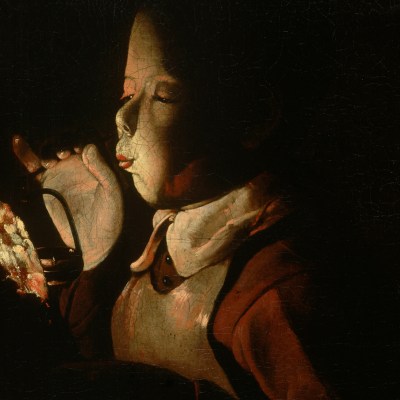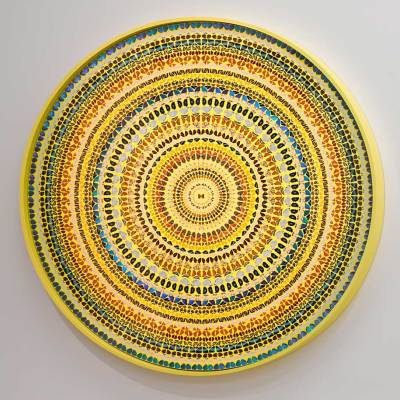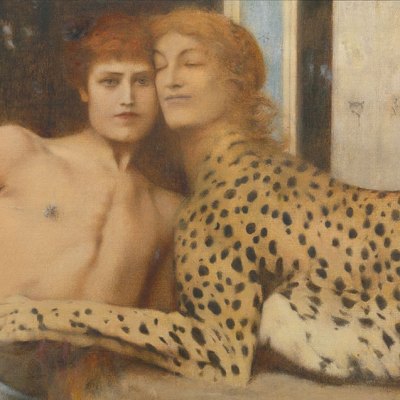In 1867, seizing on the vast crowds brought to Paris by the Universal Exhibition, Gustave Courbet (1819–77) staged a large one-man show in the capital, just as he had 12 years earlier. The venue was the Pavillon de l’Alma, a building he hoped might become his permanent studio. The presentation of recent paintings began with Death of the Hunted Stag (1867) or, to give the title reproduced in the printed booklet, Episode from a hunt with hounds over the snowy ground. This imposing and disturbing canvas signalled to visitors that hunting was to be the dominant motif of the show; it encompassed monumental depictions of animals, such as Spring Rut. The Battle of the Stags (1861); it influenced his choice of landscapes (The Hunt Meet from 1852), seascapes (Going Fishing from 1867); and even portraits, such as that of his recently deceased friend Urbain Cuénot, a passionate chasseur.
A brilliant piece of self-promotion, the 1867 retrospective testified to Courbet’s fame, or notoriety, in the Second Empire. Born in 1819 in Ornans, in the Doubs département, Courbet the wild provincial rose to conquer the Paris Salon, winning recognition for his uncompromising and monumental depictions of labourers, his unflattering and perverse accounts of rural customs, and his shockingly earthy female nudes. During the 1840s, determined to be the bête noir of academic painting, Courbet drew on 17th-century Dutch and Flemish painting to produce a wholly individual reckoning with the society of his time. With Courbet, realist painting was defined not just by its social themes but by its joyously expressive and coarse mode of execution; his use of the palette knife was something of a signature. All these elements were fused in The Artist’s Studio (1855): a résumé of his friendships, artistic credo and republican convictions, this hieroglyphic ‘real allegory’ had been the centrepiece of his one-man show of that year.
As the exhibition of 1867 demonstrated, hunting themes were of extraordinary importance to Courbet’s personal mythology and artistic practice. One of his first, unsuccessful submissions to the Salon was The Huntsmen’s Rest (1842), and he pursued the subject – or it pursued him – throughout his career, and with special vigour in his final decades. His art teems with animals: the pig incongruously walked on a leash by Flagey peasants, the cows who siesta in the Doubs mountains, the seagulls snared on a Normandy beach, or the elegant greyhounds of the Comte de Choiseul. During Courbet’s lifetime, hunting scenes were among his most admired pieces. He assured his friend Francis Wey that Spring Rut. The Battle of the Stags ‘ought to have the same impact as the Burial [of Ornans], though in a different way’.
Spring Rut. The Battle of the Stags (1861), Gustave Courbet. Musée d’Orsay, Paris. Photo: © RMN Grand-Palais (Musée d’Orsay)/Hervé Lewandowski
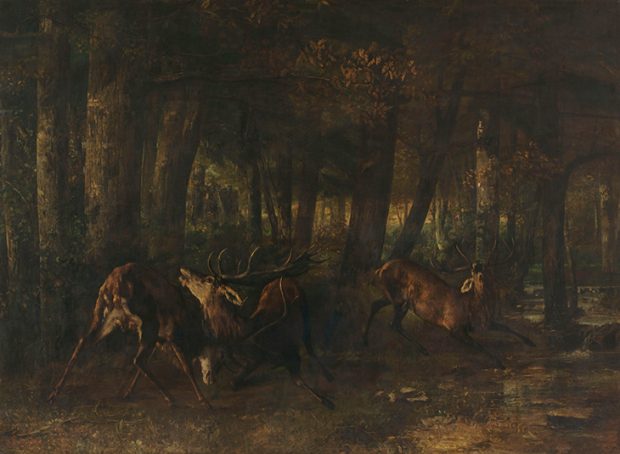
Until very recently, however, Courbet’s hunt scenes – like his late landscapes and still lifes – have been passed over in embarrassment by critics, even by his admirers. One problem is the seeming absence of political content. When Courbet was reclaimed as a revolutionary painter in post-war criticism, leftist interpreters from Louis Aragon to T.J. Clark trained their attention on his monumental and sober figure paintings. Other facets of his realism, especially after 1855, merited little comment. Such an aversion mirrored the dismay of Courbet’s contemporary socialist supporters, such as Théophile Thoré, that the painter of the proletariat had stooped to painting deer and foxes. In Champfleury’s verdict, Courbet had been diverted from his militant calling and had settled for the cosy and ‘the second rate’.
Another perceived problem with the animal paintings was their commercial profitability. Produced at a time when the painter was angling after private commissions – in lieu of support from the imperial regime – his images of the natural world can veer on the repetitive. Many of the landscapes he produced in the 1850s and ’60s, in Anne Wagner’s view, are little more than essays in pictorial ‘effects’ (impasto smears and empty horizons) produced to satisfy a queue of unimaginative buyers. Petra ten-Doesschate Chu’s brilliant edition of Courbet’s letters has revealed his preoccupation with boosting his brand and keen awareness of Landseer’s lucrative studies in animal sentimentality. According to Chu, Courbet set about selecting and ‘packaging’ views of nature that replicated the logic of leisure presented by 19th-century newspapers, with their columns on daytrips to the seaside, or notices on rural sports. These works quickly found wealthy clients outside France. In 1869, Courbet was proud to be awarded the Order of St Michael by Ludwig II of Bavaria (in marked contrast with his refusal of the Légion d’honneur the following year). The Quarry (1857) became his first work to sell in America (acquired by the Allston Club in Boston in 1866, it now hangs in the Museum of Fine Arts).
Both lines of critique have some merits, although they ignore the fascination that hunting exerted over Courbet. He indulged in it whenever he returned to his native Ornans. ‘It is an excuse for some violent exercise that I am rather fond of,’ he told his great Montpellier patron Alfred Bruyas in 1854, and his letters are full of boasts about his bloody exploits (‘I am become a fanatic poacher’). Scores of foxes, hares, deer, wolves and boars fell beneath Courbet’s bullets. During a trip to Frankfurt in 1859, he succeeded in slaying a 13-year-old stag on the St Sylvester’s day hunt. This ‘adventure aroused the envy of all Germany’, he bragged, and he preserved the teeth, antlers and skin of the animal as personal trophies. His hunting scenes conformed to his agenda of authenticity and so, when not drawing on personal experience, Courbet studied taxidermy specimens, which he greatly admired (‘this is nature caught in the act’), or cadavers of deer purchased from the butcher on rue Montorgueil.
Fox Caught in a Trap (1860), Gustave Courbet. National Museum of Tokyo.

His casual and celebratory attitude towards animal slaughter seems at odds with the expressive, often uncanny psychological presence of the animals in his paintings. As James Rubin observes, ‘Curiously, Courbet, who avoided dramatic compositions and over-emotion in human subjects allowed himself free rein in his representations of these victims of the hunt.’ The eyes of the slaughtered animals often fix on the viewer, and Courbet extracts a rare pathos from images of animal suffering. The subject of Fox Caught in a Trap (1860), a bravura display of his skill in painting fur, is also uncomfortable to look at. While he personally relished the fury of the chase, very little of this dynamism makes its way on to the canvas. Instead, Courbet dwells on the aftermath of the blood-letting. A composition like After the Hunt (c. 1859) is unsettling precisely because of its dreamy lyricism and the thoughtful expression of the man who dangles the dead fox above his snapping hounds.
This ambivalence reflects the changing nature of hunting itself, as outlined in a fine article by Shao-Chien Tseng. Once the prerogative of royal and noble families, hunting rights had been swept away with other feudal privileges during the French Revolution. Yet venery enjoyed new glamour with the restoration of the monarchy, and never more so than under the Second Empire, when elites flocked to the court hunts in the forests around Compiègne (Courbet attended one at Rambouillet courtesy of the duc de Morny). As a painter, Courbet mobilised the rich tradition of hunting art, citing Rubens, Snyders and Van Loo. But unlike his French peers in this genre – such as Louis-Godefroy Jadin – he brought to this repertoire a new sobriety and strangeness, perhaps in keeping with growing unease about the affectations of bourgeois chasseurs, or the ethical distaste of the Société Protectrice des Animaux (founded in 1845). Courbet’s hunting scenes document the familiar rituals of the hunt, but deploy them out of sequence, imbuing them with a peculiar mood of melancholy or deflation.
In recent years, while the Musée des Beaux-Arts et d’Archéologie in Besançon was being renovated, the presence of Death of the Hunted Stag in the Courbet galleries in the Musée d’Orsay, where it hung with the monumental figurative works, has vindicated this observation. The French title (L’Hallali du cerf) is an abbreviation of ‘allez à lui’ and refers to the moment after the exhausted prey has been run down. As ever, the agonised stag is the emotional core of the painting, set upon by dogs who have already ripped out and devoured its genitals, leaving a gaping black wound. These same dogs are in a state of evident arousal as they close in for the kill, investing this work with what Michael Fried calls a ‘frenzied sexuality’. Meanwhile the two human characters gaze impassively as one tries to bring the dogs to order with a whip and the other rears on his horse, his pose lifted directly from Delacroix’s sadistic Turkish rider in the Massacre at Chios. In its size, iconography and depiction of delirious passions, this is natural history with pretentions to history painting.
The Quarry (1856), Gustave Courbet. Museum of Fine Arts, Boston.
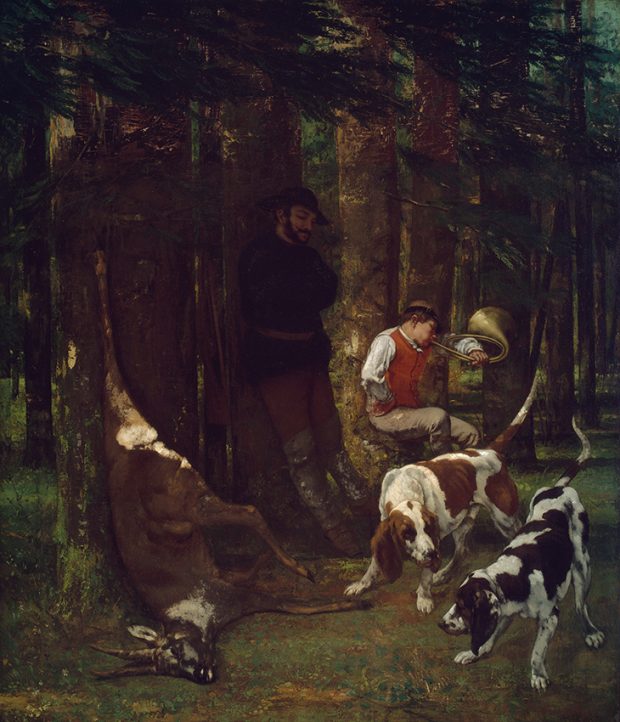
This kind of excess explains why some critics have suspected that Courbet’s animal creations contain an unsolved allegorical message. Courbet encouraged this kind of speculative reading, joking about the resemblance between his graceful assembly of roe deer at the stream of Plaisir-Fontaine in a painting from 1866 and the conversations of a Paris salon. When Henri d’Ideville commented (with relief) that at least nobody could view such a scene as a political manifesto, Courbet quickly shot back: ‘Unless what they saw […] was a secret society of roe deer assembling in the woods in order to proclaim the Republic.’ Rather than renouncing his political loyalties, perhaps Courbet was resituating his convictions on unexpected new ground. After all, he responded to the greatest political crisis of his life in 1870–71 by producing images of bloated trout and heaps of over-ripe fruit, ‘coloured symbols of life bursting from barren confines’, as Rubin puts it.
The crisis of the Paris Commune and its aftermath led to six months of imprisonment for Courbet and the requirement to pay a ruinous indemnity for his role in dismantling the Vendôme column. Throughout this ordeal he turned to the natural world to emblematise his plight. In 1876, living in Swiss exile, he revisited the motif of the murdered roe from The Quarry in a painting inscribed to ‘l’ami Cluséret’. General Gustave-Paul Cluseret had been condemned by the Conseil de Guerre for his participation in the Commune and, like Courbet, had fled to Switzerland. To that extent, the trapped creature represented both men’s experience of persecution. Two years later, after news of Courbet’s death, in January 1878 republicans who lived nearby flocked to the museum in Marseille to lay a black crepe wreath beneath The Hunted Stag (1861), treating the canvas as a proxy for its doomed creator.
These echoes and identifications challenge critics to read Courbet’s work elastically, complicating conventional categories of art and politics. A mark of what was truly revolutionary about his vision was the disregard with which he flouted the pieties of genre, ignoring the boundary between history, portraiture, landscape and still life. Courbet famously told Bruyas in 1854: ‘As for me I confess that I look at human beings with curiosity, just as I look at a horse, a tree, or any natural object, that is all.’ He painted men in their brute physicality and religion with shocking mundanity but, by extension, he imbued woods and rivers with mythic overtones. An egalitarian and a materialist, he regarded the natural world as part of the continuum of all sentient and non-sentient life. He once confessed to his friend Théophile Silvestre: ‘I even make stones think.’
A subtle anamorphism was a hallmark of Courbet’s late pictures. Looking at the Jura landscapes, modern critics have noted the womb-like forms of the caves from whence issues the river Loue. When he unveiled the massive Oak of Flagey (1864) in the Pavillon de l’Alma, Courbet turned what is often interpreted as an arboreal self-portrait into a symbol of rugged, provincial independence. Looking at the post-Commune still lifes of fruit, Fried has underlined the resemblance between the plump pears and dimpled quinces and the buttocks, breasts and navels of his female models. Can this game of spotting affinities be taken too far? In a lecture at the Getty in 2006, Linda Nochlin humorously imagined the ghost of Courbet returning to earth in disbelief and asking his modern interpreters if they thought he couldn’t tell the difference between a cliff and a cheese.
After the Hunt (c. 1859), Gustave Courbet. Metropolitan Museum of Art, New York.
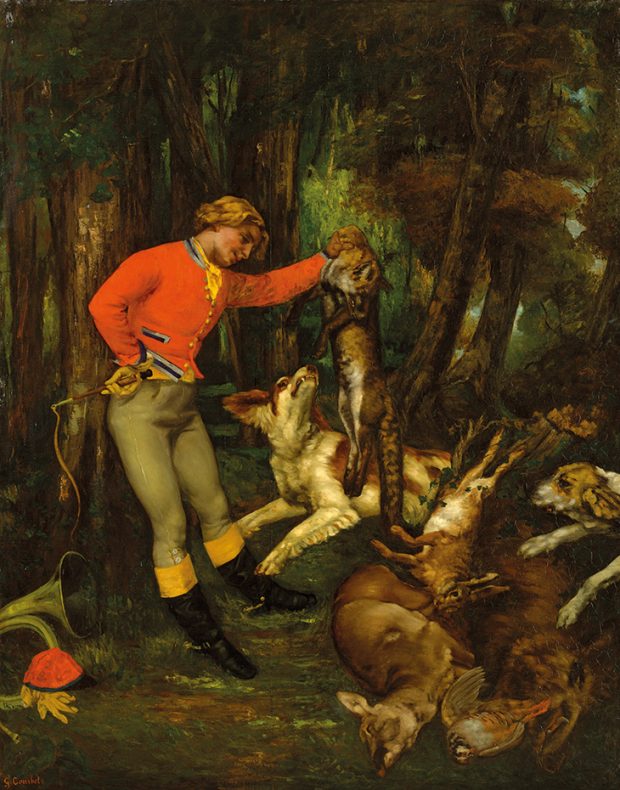
Such readings test the limits of Courbet’s realism, since they highlight a kind of pantheism that linked together seemingly disparate chapters from his consistently surprising career. ‘He seizes nature like a glutton,’ Edmond About wrote in 1857, on viewing a painting of a fox; ‘he snaps up great chunks and swallows them unchewed with the appetite of an ostrich.’ Yet while Courbet fed on nature for inspiration, his hunting scenes are those of an artist who probed into the moral consequences of such unfettered exploitation. Seemingly innocuous, his paintings of animals are evidence of his subversive and erotic flourishes, but they also betray an emotional charge that he sometimes eschewed in his more detached or ‘objective’ work.
To commemorate the bicentenary of the artist’s birth, which falls this year, two exhibitions tied to landscapes he loved explore these ambivalences. In July the Musée Courbet at Ornans produced, in association with the Fédération des chasseurs of Doubs, a compact travelling show devoted to his painting of dogs, and in October it will hang Courbet’s work alongside that of the Swiss symbolist Ferdinand Hodler. This unlikely pairing appears more plausible if we recall that the natural world was freighted with drama and mystery for Courbet. Referring to the desperate flight of The Hunted Stag, he stated that he aimed to paint a beast at once tangible and transcendent, who ‘seems to pass by like an arrow, like a dream’.
From the September 2019 issue of Apollo. Preview and subscribe here.
